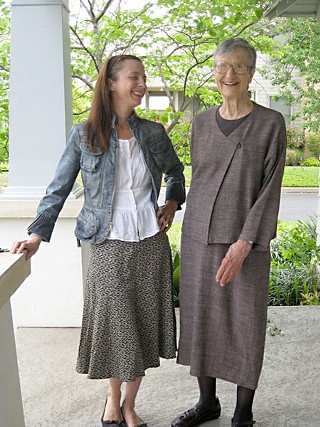Then There's This: A Pioneer Among Women Architects
Celebrated designer Natalie de Blois helped plan Austin's future
By Amy Smith, Fri., Aug. 16, 2013

Former Austin resident Natalie de Blois left her architectural mark on some of New York's most notable postwar symbols of commerce – the Park Avenue headquarters for Pepsi-Cola, Union Carbide, Lever House – but her lasting, less visible imprint on Austin is what her friends here cherish the most.
"She was one of the most straightforward individuals I've ever met in my life – no baloney, clear-eyed, and truthful," local architect Emily Little recalled of de Blois, who died July 22 in Chicago. She was 92. "She was inspirational on so many levels."
One of a few women architects during the Fifties and Sixties – a period the New York Times' David Dunlap in a recent tribute described as "architecture's 'Mad Men' era" – de Blois played key roles in the design of corporate skyscrapers during her time at the dynamo firm of Skidmore, Owings & Merrill, first in New York, then in Chicago, where she raised her four sons.
Once she landed in Austin, where she taught UT architecture students from 1980 to 1993 – her hiring was considered a major win for the university – she quickly immersed herself in the community, serving as a role model for young female architects like Little, who was in graduate school at the time, and Jana McCann, who was just starting out in her career. Today, McCann and Little each run their own firms and are among the city's most recognizable names in design, planning, and historic preservation. Their mentor also wowed architects and artists already established in their careers – Karen McGraw and Susan Wallace were among her good buddies, and longtime friend David Graeber brought her into his firm (Graeber Simmons & Cowan) as a project consultant. In her spare time, de Blois took long bicycle rides, swam in Barton Springs, and ... drafted the Downtown zoning ordinance.
At the time, in the early Eighties, McGraw was vice chair of a City Council-appointed Downtown Revitalization Task Force, initially formed to address an unpopular proposal to build a four-square-block Downtown shopping mall. "I saw Natalie at Wheatsville one day, and she asked me who on the task force was working on the Downtown zoning," McGraw said. "I told her no one, so she said, 'let's do it.'" The two spent many Saturdays hashing out and haggling over a plan, drawing on de Blois' expertise in big-city details: central business districts, high-rises, mixed-use development, loading docks, parking garages, and street frontages. "We brainstormed and sometimes argued, but started presenting our drafts to the [task force] and eventually got the entire piece approved by that group," McGraw said. From there it went to the Planning Commission and on to City Council, where it was adopted.
The ordinance includes some milestone achievements in Downtown Austin planning – Capitol view corridor protection (increasingly raising the ire of some Downtown developers), three-story height limits for Sixth Street buildings, and street frontages designed to benefit pedestrians.
As for McCann, she considers herself fortunate to have spent time with de Blois in France, where the "feisty" de Blois owned an "idyllic old farm" in the Cahors region and would live there for part of the year. McCann lived in Paris for seven years working with Atelier Bernard Kohn on the design of public spaces for six metro stations on what is now called Line 14, operated by the Paris Transit Authority. During McCann's off time, she'd take the train to Cahors, where de Blois would almost immediately put her to work on chores that needed to be done around the farm, McCann recalled with a laugh.
Neither the Times nor the Chicago Tribune's stories on de Blois' death mentioned the lasting influence she had on Austin's female architects, or her many other contributions to Austin. But then, how would they know, when de Blois never touted her accomplishments? "On a subconscious level we just got this real strong message from her that you can be competent, completely professional and brilliant about what you do, but you don't have to be a big blowhard about it," said Little. "She never tooted her own horn – never, ever, ever."
Got something to say on the subject? Send a letter to the editor.








